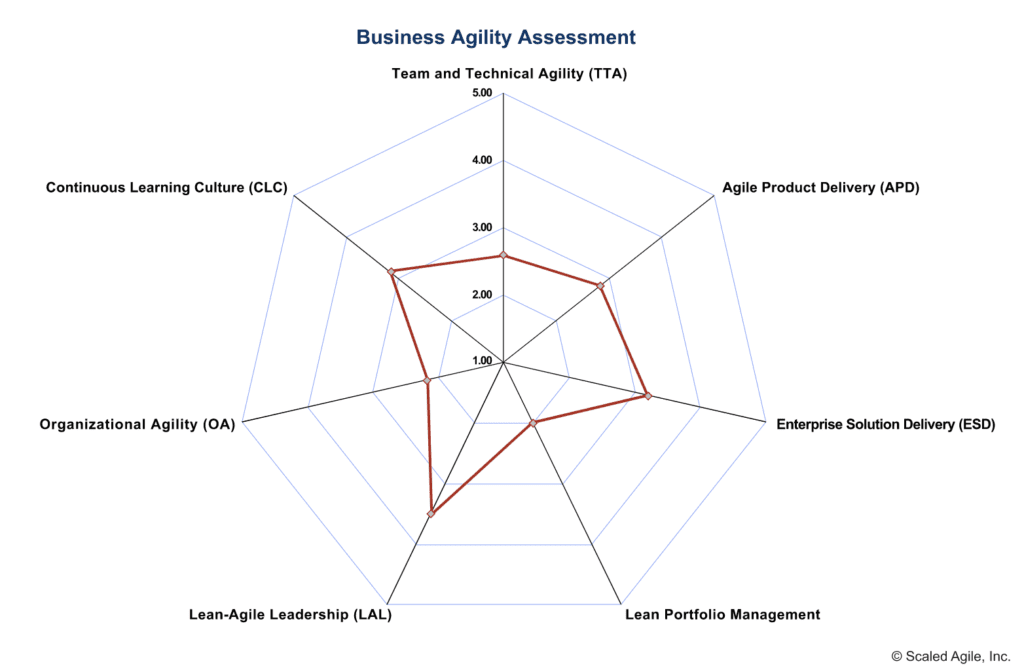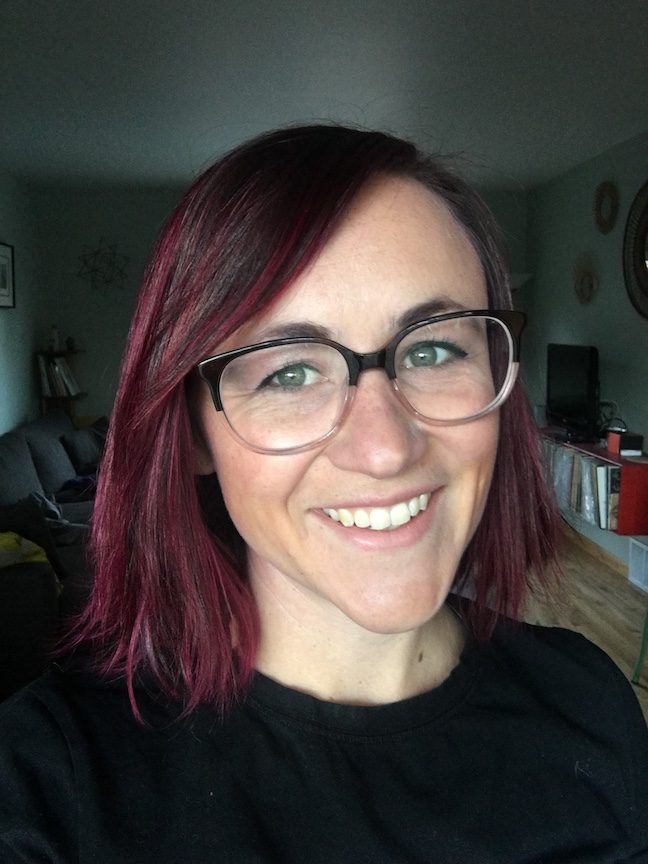Assessing your team’s agility is an important step on the path to continuous improvement. After all, you can’t get where you want to go if you don’t know where you are. But you probably have questions: How do you measure a team’s agility, anyway? Who should do it, and when? What happens with the data you collect, and what should you do afterwards?
To bring you the answers, we interviewed two of our experienced scrum masters, Lieschen Gargano and Sam Ervin. Keep reading to learn their recommendations for running a Team successfully and Technical Agility Assessment.
Q: How does SAFe help teams measure their agility, and why should I care?
Measure and Grow is the Scaled Agile Framework’s approach to evaluating agility and determining what actions to take next. Measure and Grow assessment tools and recommendation actions help organizations and teams reflect on where they are and know how to improve.
The SAFe® Business Agility Assessment measures an organization’s overall agility across seven core competencies: team and technical agility, agile product delivery, enterprise solution delivery, Lean portfolio management, Lean-agile leadership, organizational agility, and continuous learning culture.

The SAFe Core Competency Assessments measure each of these core competencies on a deeper level. For example, the Team and Technical Agility (TTA) Core Competency Assessment helps teams identify areas for improvement, highlight strengths worth celebrating, and baseline performance against future growth. It asks questions about how your team operates. Do team members have cross-functional skills? Do you have a dedicated PO? How are teams of teams organized in your agile release trains (ARTs)? Do you use technical practices like test-driven development and peer review? How does your team tackle technical debt?
For facilitators, including scrum masters, the Team and Technical Agility Assessment is a great way to create space for team reflection beyond a typical retrospective. It can also increase engagement and buy-in for the team to take on actionable improvement items.
Q: Who should run a Team and Technical Agility Assessment?
Running assessments can be tricky. Teams might feel defensive about being “measured.” Self-reported data isn’t always objective or accurate. Emotions and framing can impact the results. That’s why SAFe recommends that a scrum master or other trained facilitator run the assessment. A scrum master, SPC, or agile coach can help ensure that teams understand their performance and know where to focus their improvement efforts.
Q: When should I do this assessment?
It’s never too early or too late to know where you stand. Running the assessment for your team when you’re first getting started with an agile transformation will help you target the areas where you most need to improve, but you can assess team performance at any time.
As for how frequently you should run it … it’s probably more valuable to do it on a cadence—either once a PI or once a year, depending on the team’s goals and appetite for it. There’s a lot of energy in seeing how you grow and progress as a team, and it’s easier to celebrate wins that are demonstrated through documented change over time than through general sentiment.
Q: Okay, how do I prepare for and run it?
The agility assessment tools are available free to SAFe members and customers at the Measure and Grow page on the SAFe Community Platform. There you can choose from tools created for us by our partners, AgilityHealth and Comparative Agility.
Before you start the Team and Technical Agility Assessment, define your team’s shared purpose. This will help you generate buy-in and excitement. If the team feels like they’re just doing the assessment because the scrum master said so, it won’t be successful. They have to see value in it for them, both as individuals and as a team.
Some questions we like to ask to set this purpose include, “What do we want it to feel like to be part of this team, two PIs from now?” And, “How will our work lives be improved when we check in one year from now?”
There are two ways you can approach running this assessment. Option #1 is to have team members take the assessment individually, and then get together to discuss their results as a group. Option #2 is to discuss the assessment questions together and come to a consensus on the group’s answers.
When we’ve run this assessment we’ve had team members do it individually, so we could focus our time together on review and actions. If you do decide to run it asynchronously it’s important as a facilitator to be available to team members, in case they have questions before you review your answers as a team.
Q: What else should I keep in mind?
We like to kick off the assessment with a meeting invitation that includes a draft agenda. Sending this ahead of time gives everyone a chance to prepare. You can keep the agenda loose so you have flexibility to spend more or less time discussing particular areas, depending on how your team chooses to engage with each question.
Q: Is the assessment anonymous?
Keeping the answers anonymous is really helpful if you want to get more accurate results. We like to be very clear upfront that the assessment will be anonymous, so that team members can feel confident about being honest in their answers.
For example, with our teams, we not only explained the confidentiality of individuals’ answers but demonstrated in real-time how the tool itself works so that the process would feel open and transparent. We also made it clear that we would not be using the data to compare teams to each other, or for any purpose other than to gain a shared understanding of where we are selecting improvement items based on the team’s stated goals.
Q: Then what? What do I do with the results?
Once you’ve completed the assessment using one of the two approaches, you’ll want to review the sections one by one, showing the aggregate results and allowing the team to notice their top strengths and top areas for improvement. Your job as facilitator is NOT to tell them what you think based on the results; it’s to help guide the team’s own discussion as they explore the answers. This yields much more effective outcomes!
One thing one of us learned in doing the assessment was how much we disagreed on some things. For example, even with a statement as simple as, “Teams execute standard iteration events,” some team members scored us a five (out of five) while others scored us a one. We treated every score as valid and sought to understand why some team members scored high and others low, just like we do when estimating the size of a user story. During this conversation, we learned an important fact. The product owner thought the iteration was executed in a standard way because she was the one executing it. But team members gave that statement a low score because they weren’t included in much of the decision-making. There was no consensus understanding for what “standard iteration events” meant to the team.
This prompted a conversation about why the team isn’t always included in how the iteration was executed. We talked about the challenge of aligning schedules to share responsibility for decision-making in meetings. And we talked about the impact of team members not having the opportunity to contribute.
As a result, the assessment did more than help us see where we needed to improve; it showed us where we had completely different perspectives about how we were doing. It prompted rich conversations that led to meaningful progress.
Q: Okay, I ran the assessment; now what? What are the next steps?
With your assessment results in hand, it’s now time to take actions that help you improve. For each dimension of the Team and Technical Agility Assessment, SAFe provides growth recommendations to help teams focus on the areas that matter most and prioritize their next steps. You should:
- Review the team growth recommendations together to generate ideas
- Select your preferred actions (you can use dot voting or WSJF calculations for this; SAFe® Collaborate has ready-made templates you can use)
- Capture your team’s next steps in writing: “Our team decided to do X, Y, and Z.”
- Follow through on your actions, so that you’re connecting them to the desired outcome
- Check in on your progress at the beginning of iteration retrospectives
Finally, you’ll want to use these actions to set a focus for the team throughout the PI, and check in with business owners at PI planning on how these improvements have helped the organization make progress toward its goals.
Q: I’m ready! How do I get started?
Fantastic. Just visit the Measure and Grow page at the SAFe Community Platform to choose your assessment tool. While you’re there, you can watch the video for tips or download the Measure and Grow Toolkit for play-by-play guidance. As you’re running the assessment, use the SAFe Collaborate templates to guide the discussion and identify actions and next steps.
Have fun!
About the authors

Lieschen is a product owner and former scrum master at Scaled Agile. She’s also an agile coach and conflict guru—thanks in part to her master’s degree in conflict resolution. Lieschen loves cultivating new ideas and approaches to agile to keep things fresh and exciting. And she’s passionate about developing best practices for happy teams to deliver value in both development and non-technical environments. Fun fact? “I’m the only person I know of who’s been a scrum master and a scrum-half on a rugby team.”

Sam is a certified SAFe® 5.0 Program Consultant (SPC) and serves as the scrum master for several teams at Scaled Agile. His recent career highlights include entertaining the crowd as the co-host of the 2019 and 2020 Global SAFe® Summits. A native of Columbia, South Carolina, Sam lives in Denver, CO, where he enjoys CrossFit and Olympic weightlifting.
Share:
Back to: All Blog Posts
Next: The Unparalleled Value of Emotional Intelligence, Part Two